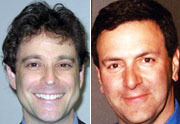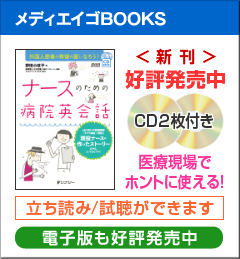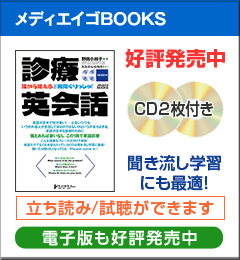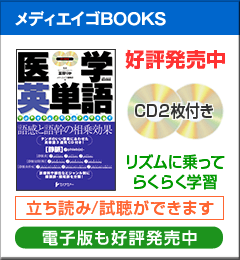

(C) Washington University in St. Louis
研究責任者のMichael S. Avidan准教授(左)と共同研究者のAlex S. Evers教授(右)
麻酔が効いたように見える患者が痛みを感じたり,手術中の苦痛や出来事を覚えていたりする現象,「麻酔中の覚醒」は,1,000人中1~2人で起こるという。この現象について,患者の状態をモニターする装置を使っても防止できない可能性が,約2,000人に関する研究で明らかになった。患者の覚醒の程度を,脳波を使った新たなモニター法と患者の息を使った従来のモニター法で調べると,どちらの方法でも2人が覚醒を経験していたという。現状では脳波によるモニターが最も良い方法とされており,将来的にもっと詳しく調査する必要がありそうだ。(吉田素子)
Anesthesiology(1) researchers(2) at Washington University School of Medicine in St. Louis have found that a device(3) to ensure(4) that surgery(5) patients have no memories of their operations may not lower risk of the phenomenon(6) known as anesthesia awareness(7).
"Anesthesia awareness implies(8) that a person was able to form memories(9) while under anesthesia(10)," says principal investigator(11) Michael S. Avidan, M.B..(12), B.Ch.(13), associate professor(14) of anesthesiology and surgery. "It's extremely(15) rare, only occurring in about one to two surgical(16) patients per thousand, but because of the huge number of(17) operations performed annually(18), the total number of people with awareness during anesthesia is significant(19). It can be distressing(20) and can contribute to(21) long-term, psychological(22) consequences(23) such as anxiety(24) and even post-traumatic stress disorder(25) in some cases."
Reporting in the March 13 issue of the New England Journal of Medicine, a team led by Avidan compared outcomes(26) in almost 2,000 surgery patients who were treated at Barnes-Jewish Hospital in St. Louis. Half were monitored(27) with a device that measures bispectral index(28) (BIS). The BIS measurement takes data from an electroencephalogram(29) that monitors brain waves(30). When a person is fully awake(31), their BIS measurement is 100. No brain wave activity would be rated as zero. Anesthesiologists(32) who use BIS monitors(33) are advised to(34) adjust patients' anesthesia in order to keep the reading(35) between 40 and 60 to prevent anesthesia awareness during surgery.
Investigators(35) used end-tidal anesthetic gas(36) (ETAG) to guide anesthesia administration(37) in the rest of the study patients.
(1) 麻酔学 (2) 研究者 (3) 装置 (4) 確実に~する (5) 手術 (6) 現象 (7) 麻酔中の覚醒
(8) ~という意味を含む (9) 記憶を形成する (10) 麻酔 (11) 研究責任者) (12) 医学士
(=Bachelor of Medicine) (13) 外科学士(=Bachelor of Surgery) (14) 准教授 (15) かなり
(16) 手術の (17) 膨大な数の (18) 年間 (19) かなり多い (20) 苦痛である (21) ~の原因となる
(22) 心理学的 (23) 影響 (24) 不安 (25) 心的外傷後ストレス障害 (26) 結果 (27) モニターされた
(28) バイスペクトラル・インデックス(脳の覚醒や鎮静状態を表す指標) (29) 脳波計 (30) 脳波
(31) 完全に目覚めている (32) 麻酔専門医 (33) モニター (34) ~するよう勧められる (35) 測定値
(36) 研究者 (37) 呼吸終期の麻酔ガス (38) 投与


